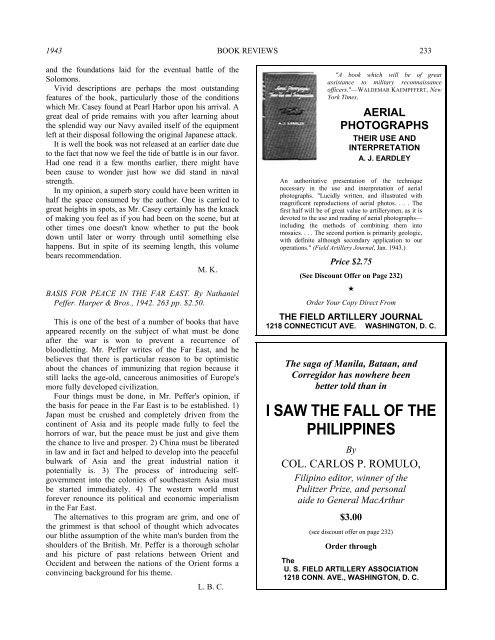the field artillery journal - Fort Sill - U.S. Army
the field artillery journal - Fort Sill - U.S. Army
the field artillery journal - Fort Sill - U.S. Army
Create successful ePaper yourself
Turn your PDF publications into a flip-book with our unique Google optimized e-Paper software.
1943 BOOK REVIEWS 233<br />
and <strong>the</strong> foundations laid for <strong>the</strong> eventual battle of <strong>the</strong><br />
Solomons.<br />
Vivid descriptions are perhaps <strong>the</strong> most outstanding<br />
features of <strong>the</strong> book, particularly those of <strong>the</strong> conditions<br />
which Mr. Casey found at Pearl Harbor upon his arrival. A<br />
great deal of pride remains with you after learning about<br />
<strong>the</strong> splendid way our Navy availed itself of <strong>the</strong> equipment<br />
left at <strong>the</strong>ir disposal following <strong>the</strong> original Japanese attack.<br />
It is well <strong>the</strong> book was not released at an earlier date due<br />
to <strong>the</strong> fact that now we feel <strong>the</strong> tide of battle is in our favor.<br />
Had one read it a few months earlier, <strong>the</strong>re might have<br />
been cause to wonder just how we did stand in naval<br />
strength.<br />
In my opinion, a superb story could have been written in<br />
half <strong>the</strong> space consumed by <strong>the</strong> author. One is carried to<br />
great heights in spots, as Mr. Casey certainly has <strong>the</strong> knack<br />
of making you feel as if you had been on <strong>the</strong> scene, but at<br />
o<strong>the</strong>r times one doesn't know whe<strong>the</strong>r to put <strong>the</strong> book<br />
down until later or worry through until something else<br />
happens. But in spite of its seeming length, this volume<br />
bears recommendation.<br />
M. K.<br />
BASIS FOR PEACE IN THE FAR EAST. By Nathaniel<br />
Peffer. Harper & Bros., 1942. 263 pp. $2.50.<br />
This is one of <strong>the</strong> best of a number of books that have<br />
appeared recently on <strong>the</strong> subject of what must be done<br />
after <strong>the</strong> war is won to prevent a recurrence of<br />
bloodletting. Mr. Peffer writes of <strong>the</strong> Far East, and he<br />
believes that <strong>the</strong>re is particular reason to be optimistic<br />
about <strong>the</strong> chances of immunizing that region because it<br />
still lacks <strong>the</strong> age-old, cancerous animosities of Europe's<br />
more fully developed civilization.<br />
Four things must be done, in Mr. Peffer's opinion, if<br />
<strong>the</strong> basis for peace in <strong>the</strong> Far East is to be established. 1)<br />
Japan must be crushed and completely driven from <strong>the</strong><br />
continent of Asia and its people made fully to feel <strong>the</strong><br />
horrors of war, but <strong>the</strong> peace must be just and give <strong>the</strong>m<br />
<strong>the</strong> chance to live and prosper. 2) China must be liberated<br />
in law and in fact and helped to develop into <strong>the</strong> peaceful<br />
bulwark of Asia and <strong>the</strong> great industrial nation it<br />
potentially is. 3) The process of introducing selfgovernment<br />
into <strong>the</strong> colonies of sou<strong>the</strong>astern Asia must<br />
be started immediately. 4) The western world must<br />
forever renounce its political and economic imperialism<br />
in <strong>the</strong> Far East.<br />
The alternatives to this program are grim, and one of<br />
<strong>the</strong> grimmest is that school of thought which advocates<br />
our bli<strong>the</strong> assumption of <strong>the</strong> white man's burden from <strong>the</strong><br />
shoulders of <strong>the</strong> British. Mr. Peffer is a thorough scholar<br />
and his picture of past relations between Orient and<br />
Occident and between <strong>the</strong> nations of <strong>the</strong> Orient forms a<br />
convincing background for his <strong>the</strong>me.<br />
L. B. C.<br />
"A book which will be of great<br />
assistance to military reconnaissance<br />
officers."—WALDEMAR KAEMPFFERT, New<br />
York Times.<br />
AERIAL<br />
PHOTOGRAPHS<br />
THEIR USE AND<br />
INTERPRETATION<br />
A. J. EARDLEY<br />
An authoritative presentation of <strong>the</strong> technique<br />
necessary in <strong>the</strong> use and interpretation of aerial<br />
photographs. "Lucidly written, and illustrated with<br />
magnificent reproductions of aerial photos. . . . The<br />
first half will be of great value to <strong>artillery</strong>men, as it is<br />
devoted to <strong>the</strong> use and reading of aerial photographs—<br />
including <strong>the</strong> methods of combining <strong>the</strong>m into<br />
mosaics. . . . The second portion is primarily geologic,<br />
with definite although secondary application to our<br />
operations." (Field Artillery Journal, Jan. 1943.)<br />
Price $2.75<br />
(See Discount Offer on Page 232)<br />
�<br />
Order Your Copy Direct From<br />
THE FIELD ARTILLERY JOURNAL<br />
1218 CONNECTICUT AVE. WASHINGTON, D. C.<br />
The saga of Manila, Bataan, and<br />
Corregidor has nowhere been<br />
better told than in<br />
I SAW THE FALL OF THE<br />
PHILIPPINES<br />
By<br />
COL. CARLOS P. ROMULO,<br />
Filipino editor, winner of <strong>the</strong><br />
Pulitzer Prize, and personal<br />
aide to General MacArthur<br />
$3.00<br />
(see discount offer on page 232)<br />
Order through<br />
The<br />
U. S. FIELD ARTILLERY ASSOCIATION<br />
1218 CONN. AVE., WASHINGTON, D. C.

















